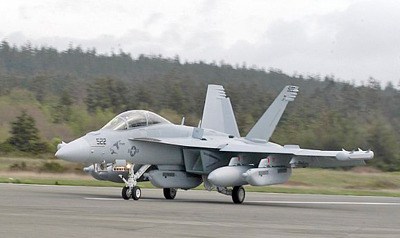Grass roots opposition to noise from EA 18G “Growlers” is spreading to the San Juan Islands.
The noise from thousands of engine tests and training runs by new EA 18G “Growlers” and other planes at Naval Air Station Whidbey and Outlying Landing Field Coupeville has generated two recent community meetings on Lopez and San Juan islands, and another meeting at 11:30 a.m. on Saturday, March 15, at the Grange in Friday Harbor.
At the meeting on Lopez last month, about 70 islanders complained that increased noise and number of missions impact their quality of life and property values. Leaders of Citizens of Ebey’s Reserve presented additional information about multiple health and hearing problems caused by the planes. Ebey’s Reserve is the location of OLF Coupeville.
COER encouraged Lopezians to join their movement to have the “touch-and-go” training runs by the Growlers moved to other, less populated areas – such as the 1.1 million acre China Lake, Calif., naval weapons station in the Mojave Desert.
The response from Lopez: organize a trip to Washington, D.C. to meet with senators Maria Cantwell and Patty Murray and Representative Rick Larsen. San Juan County Councilman Jamie Stephens, who participated in the Lopez meeting, said he has been in touch with the commanding officer of NAS Whidbey, and he has been invited to bring a delegation of Lopez residents to the air station to talk about the problem.
COER leaders Michael Monson and Richard Abraham came to the Brickworks on San Juan Island March 13 with a message similar to the one delivered on Lopez, but with some news. Monson reported that he has information that EA-18 training had been temporarily moved to Naval Air Station Fallon, in Nevada. Monson said his organizations and its allies, including the Concerned Island Citizens and the Whidbey Noise Coalition, are not seeking to close NAS Whidbey, but do want the EA-18s relocated.
Monson, Abraham and COER founder Ken Pickard, along with Maryon Attwood and Kate Andrews, met with almost fifty islanders again on Saturday, March 15, at the Grange in Friday Harbor with the same message, expressed by Pickard: scientific measurements of sound levels in excess of EPA health standards and common sense says Whidbey Island and Puget Sound is no place for Growler or any low-level aircraft training operations. “We just can’t live normal lives with this noise,” said Pickard.
Monson said he believes the planes were training in Nevada to avoid using NAS Whidbey and OLF Coupeville, but Mike Wilding, a spokesman for NAS Whidbey, said in a statement to the Journal that “the Growler and Prowler squadrons go to NAS Fallon to conduct Large Force Exercises with the other squadrons in the air wing …. This is a normal part of their training cycle. They do not conduct Field Carrier Landing Practice (the type of touch-and-go training conducted at OLF) at NAS Fallon.”
Asked about the Navy’s current Environmental Impact Statement study concerning EA-18 operations in the area, Wilding also stated, “There were some scoping questions related to noise in the San Juan Islands, and those scoping comments will be addressed in the EIS. It is important to remember that Navy aircraft have been operating in the area since 1940’s… Existing Prowler and Growler operations are consistent with previous environmental studies. These noise impacts in those studies are depicted in the noise contours published at www.cnic.navy.mil.
Pickard of COER says flatly that the number and frequency of Growler operations are not “consistent with previous environmental studies.” “Contrary to the assumption in the 2005 EA [the Environmental Assessment performed before Growlers arrived at NAS Whidbey] that the number of flight operations would decrease, the number has actually significantly increased,” according to the COER paper, “Facts Regarding OLF Noise.”
The current draft environmental impact statement by the Navy will be released for public comment in 2015; the final document will be finished in 2016.
Wilding also wrote, “While individuals may hear and see Navy aircraft, the existing analysis demonstrates that the noise impacts are located primarily in the immediate vicinity of Ault Field and OLF Coupeville, and the San Juan Islands are not currently located within the AICUZ noise contours. This EIS will study proposed changes to Growler operations, including possible changes to our existing, published DNL noise contours. If this new noise study shows changes in impacts, the EIS will describe those changes, regardless of where those changes may occur. We do get occasional comments from citizens in the San Juan Islands, the majority of which are from the southern end of Lopez Island.”
Support for the Navy and NAS Whidbey includes many Whidbey Island local governments and businesses, due in part to the local economic impact on Whidbey Island, which Wilding put at $1.085 billion. According to Wilding, a 2004 Washington State study reported this represents “more than 85 percent of all economic activity and 68 percent of all jobs on Whidbey Island… .”
The issue has been joined, and San Juan County is joining the issue.




